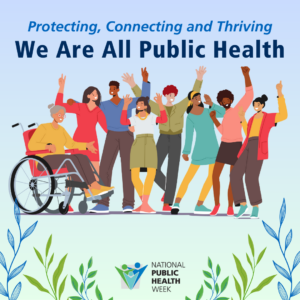
April 1-7 is National Public Health Week 2024. This year’s theme is “Protecting, Connecting and Thriving: We Are All Public Health.” This holistic approach to public health was certainly evident in Governors’ 2024 State of the State addresses, in which they highlighted the need to continue to invest in and support the health and well-being of their constituents. Issues at the top of mind for Governors include expanding behavioral health services and supports, investing in public health infrastructure, developing policy to improve maternal and child health outcomes, bolstering the healthcare workforce and expanding access to needed care, especially in rural and underserved communities. The highlights outlined here represent key themes that emerged from a scan of 2024 State of the State addresses.
A link to each Governor’s address is available on the NGA 2024 State of the State page located here.
Behavioral Health

Addressing behavioral health continues to be atop priority for Governors. In State of the State addresses, 28 Governors identified behavioral health as a top priority for their administration, including increasing supports and services for people with substance use disorder, and efforts to support youth mental health.
- New York Governor Kathy Hochul: “We’ve all seen lives, in every corner of the state sapped by opioid dependence. My own family has been touched by this epidemic of pain. I still mourn the loss of my nephew and the millions of other lives needlessly cut short. And that’s why we’re harnessing over $200 million in settlement funds to bolster and support our addiction treatment professionals, grow our street outreach efforts, and distribute more naloxone and millions more life-saving fentanyl test strips.”
- Iowa Governor Kim Reynolds: “We’ve made significant progress over the last several years, investing millions in behavioral health providers, creating the state’s first children’s mental health system, and funding numerous impactful projects around the state. One of those projects will soon mark a pivotal moment for Iowa’s youth. This year YSS, a youth-centered non-profit, will open Ember Recovery Campus, a groundbreaking new facility offering 70 behavioral-health beds that will focus on emergency shelter, crisis stabilization, and addiction treatment. This project, the first of its kind in Iowa, represents the largest public private investment in children’s behavioral health in our history and is a model for our state.”
- Wisconsin Governor Tony Evers: I’m creating an Interagency Council on Mental Health and directing Wisconsin state agencies to work together to reduce barriers and address gaps in mental health services. We’re going to develop a statewide Mental Health Action Plan to address the root causes of our mental health crisis, increase awareness and reduce stigma, and build capacity for us to expand access to mental health services statewide.
- Virginia Governor Glenn Youngkin: “The Road to Opportunity for many Virginians will be cleared by accelerating the transformation of our behavioral health system — a transformation desperately needed given the clear behavioral health crisis that we face. And while this is a three year journey, we just celebrated the one-year anniversary of our “Right Help, Right Now” transformation. This time last year, we’d hoped to have 2 new emergency room alternatives, and today we have 8, and there’s more to come. In the month of November alone, we received over 8,300 calls on the 988 line. And Virginia is among the top in the nation in answering those calls quickly…The transformation is working, but we need to do more.”
- Washington Governor Jay Inslee: “We propose $64 million in new spending to fight against opioids and fentanyl. We’re going to invest in education, community health hubs, overdose prevention, treatment access, and recovery supports.”
- Idaho Governor Brad Little: “Our children need our protection in all aspects of their lives, including their personal lives. We know young people today face greater levels of distress and isolation than any other generation before them. To help keep our children well, IDAHO WORKS doubles the funding for school advisors. These are the professionals on the front lines in talking to students about their futures as well as their current personal struggles. IDAHO WORKS also proposes a new Statewide Student Behavioral Health Initiative for additional suicide prevention.”
- Guam Governor Lou Leon Guerrero: “If you have a child with autism, Behavioral Health is partnering with community organizations to provide evidence-based parent training and Applied Behavioral Analysis services for children with autism spectrum disorders. With Child Care Development Funds, we are expanding our ability to provide these valuable services, a gold standard of care for the autism community. Now we can help keep families here instead of forcing them off island.”
- North Dakota Governor Doug Burgum: “We’ve made great strides through access and services to people facing addiction. We know that our state’s behavioral health providers are increasingly challenged by workforce shortages. So in addition to the peer support specialist program we’re also working with in the coming months, we’re going to work with the university leaders, the health care system, private sector to help solve this critical issue.”
Public Health

Governors continue to focus on public health infrastructure as it provides the foundation for all public health services; this includes prevention and treatment for chronic and infectious diseases, improving population health and emergency preparedness efforts.
- U.S. Virgin Islands Governor Albert Bryan Jr. “The future of public health centers depends on health equity. Predicting and preventing illnesses at the community level lessens disease severity, and that will serve to reduce the economic burden of healthcare. The pandemic also pushed us into the digital age, with public health increasingly dependent on automation and integrated systems for comprehensive program and service delivery. Today, the Department of Health (DOH) and our Office of Health Information Technology are actively reimagining the public health landscape in the territory.”
- Indiana Governor Eric Holcomb: “Along with READI 2.0, recognizing health is wealth, our Health First Indiana program is the nation’s most substantial new commitment to public health, and will further empower Indiana counties to create tailored actions.”
Maternal and Child Health

Maternal and child health remains a priority for Governors. In 2024 State of the State addresses, Governors outlined actions they are taking in their states to improve maternal and child health outcomes including initiatives and programs to improve care coordination, bolster the workforce and expand Medicaid coverage for new parents. NGA continues to support Governors in their efforts to support maternal and child populations.
- Illinois Governor JB Pritzker: “Beginning this year, doulas, midwives, and lactation consultants can now be recognized as Medicaid healthcare providers, ensuring that they can be fairly compensated. That will make more services more readily available to communities with the highest mortality rates. But we can do even more. I intend to break down bureaucratic barriers in state government by coordinating work across agencies to improve access to a full spectrum of reproductive healthcare services. Our Department of Public Health will provide grants to assist providers with Medicaid certification and licensing associated with starting and sustaining a community-based practice.”
- South Dakota Governor Kristi Noem: “We care about the lives of our mothers and children. We have dedicated resources and time. But we can still do more to prevent the rising death rates of South Dakota moms and babies, particularly among Native Americans living on tribal lands. So what are we doing in South Dakota? We are offering the Bright Start program to get one-on-one nursing services to first-time moms and their babies from pregnancy until the child’s second birthday. The Department of Social Services’ Pregnancy Health Home will offer care coordination to all pregnant mothers who are enrolled in Medicaid. These moms also have access to prenatal and postpartum coverage for up to a year after birth along with well-child and health maintenance exams.”
- Rhode Island Governor Dan McKee: “We know how important Early Intervention is for our children and families. This crucial program promotes the development of infants and toddlers who have a developmental disability or delay.”
- Iowa Governor Kim Reynolds: “Today, Medicaid only covers postpartum care for two months after birth. I’m proposing to expand that coverage to 12 months, for new moms who make less than $42,000 a year. Let’s do more to help moms, babies, and their families get off to a good start.”
Healthcare Equity and Workforce Challenges

Governors are also prioritizing advancing health equity to help all people attain their highest level of health. Through investments in communities that could most benefit from or most need resources, especially in rural areas, Governors are committing to addressing workforce challenges and improving healthcare access in underserved areas to support the health and wellbeing of all their constituents.
- Tennessee Governor Bill Lee: “We know we have challenges with access to care and workforce shortages. That’s why I formed the Rural Healthcare Task Force in 2021 to explore solutions to address the issue head-on. These solutions are becoming a reality. We will be expanding apprenticeships, providing greater access to specialty care and telehealth, better pathways from high school to healthcare careers, and much more… So, this year, building off the recommendations from the task force, we will propose the single largest investment in rural healthcare in state history – nearly $200 million over the next five years.”
- Hawaii Governor Josh Green: “We are placing an extra emphasis on selecting mental health and addiction treatment professionals to address heightened concerns that have arisen from the COVID era and the disaster on Maui… This initiative will help ensure that rural and under-served communities across our state have access to the healthcare providers that they need — and within five years, Hawaiʻi will be the only state in the nation without a shortage of doctors, nurses, or social workers… We will finally be able to bring an end to the healthcare disparities that many of our communities have suffered for too long.”
- Alabama Governor Kay Ivey: “One of our greatest needs remains within our healthcare workforce, especially in Rural Alabama. There is simply no denying it, and we need more people to fill just about every kind of healthcare job out there – doctors, nurses, techs, you name it. Last year, I introduced the idea of the Alabama School of Healthcare Sciences. This school will directly expose young men and women from around Alabama, and particularly rural students, to various healthcare fields. And it gives them options. Maybe they want to graduate with a credential to immediately start working a high wage career, or maybe they want to go to college and become a nurse or maybe even attend medical or dental school. We will now give these students an opportunity and a state-of-the-art school to attend.”
- New Mexico Governor Lujan Grisham: “We’ve increased Medicaid provider rates and expanded the Health Care Professional Loan Repayment Program to keep more doctors, nurses and health care workers in our state. And with the $80 million from the Rural Health Care Delivery Fund we awarded last year, we have made it easier for New Mexicans to get the healthcare they need.”
- Kansas Governor Laura Kelly: “Simply put, our rural hospitals are not doing well. In just the past decade, eight have closed … Because so many of our hospitals are hanging on by a thread, they’re forced to increase costs for patients, to lay off healthcare and other essential workers, to stop offering important services. Then, counties often resort to raising property taxes in a last-ditch effort to keep those hospitals afloat…and, when that fails, Kansans must drive longer and longer distances for basic care. So much of the problem boils down to one thing: far too many Kansans don’t have health insurance. In particular, working Kansans who don’t have employer-based insurance but who make too much money to qualify for our current Medicaid program. These are Kansans who work at the local hair salon or barbershop, who care for your elderly parent at the nursing home, who watch your kids so you can work.”
As demonstrated in the priorities outlined in their 2024 State of the State and budget addresses, and detailed in this commentary, Governors continue to focus on ways to improve the health and well-being of their constituents. As Governors move forward with these efforts, NGA’s Behavioral Health, Public Health and Healthcare Delivery program teams will continue to work with states and territories to help them achieve their goals. This will include helping Governors develop implementation plans, connecting them with state and other experts who can assist them, and supporting the staff they have tasked to carry out this work.












